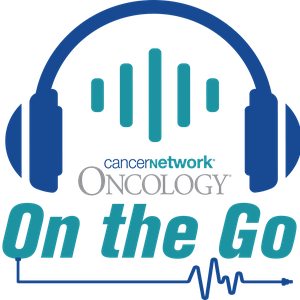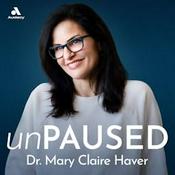219 episodios

S1 Ep193: Distress Screening: Making the Fifth Vital Sign Integral to Oncology Care
22/12/2025 | 47 min
This episode of the collaborative podcast between Oncology on the Go and the American Psychosocial Oncology Society (APOS), hosted by Daniel C. McFarland, DO, features Michelle B. Riba, MD, and focuses on integrating psychosocial care into oncology for clinicians. The discussion emphasizes that psychosocial issues profoundly impact both quality of life and cancer-related outcomes, making their assessment an integral part of care, not merely ancillary. The distress thermometer was developed by the NCCN in the late 1990s as a 0-to-10 scale, dubbed the "fifth vital sign". The term "distress" was chosen over psychiatric labels to capture the wide array of patient concerns, including pain, fatigue, sleep, spiritual, practical, and family issues. Distress screening is now mandated at regular appointments in all cancer centers in the US. Clinicians are encouraged to screen for more specific issues like depression (linked to poor adherence and survival), anxiety (which can impede treatment adherence), and substance use. Oncologists are the doctors most able to consider a patient's totality of symptoms, and their role is integral to supporting psychosocial referrals. To address the practical delivery of care, the collaborative care model is being advocated as a public health, population-based approach. Key components include: Use of a standardized screening tool. Management by a dedicated care manager. Weekly consultation between the care manager and a consultant psychiatrist for triage and treatment advice. The model allows oncologists to bill for care and learn more about these issues while ensuring patients receive evidence-based treatments. The clinicians concluded that fundamentally, mental health needs to be aligned alongside cancer care. McFarland is the director of the Psycho-Oncology Program at Wilmot Cancer Center and a medical oncologist who specializes in head, neck, and lung cancer, in addition to being the psycho-oncology editorial advisory board member for the journal ONCOLOGY. Riba is director of the PsychOncology Program, a clinical professor, and the associate chair for Integrated Medical and Psychiatric Services in the Department of Psychiatry at the University of Michigan Rogel Cancer Center, and psycho-oncology editorial advisory board member for the journal ONCOLOGY.

S1 Ep192: ASH 2025: Key Discussions in Multiple Myeloma, Lymphoma, and Leukemia
15/12/2025 | 10 min
At the 2025 American Society of Hematology Annual Meeting & Exposition (ASH), CancerNetwork® sat down with a variety of researchers and clinicians to discuss potential advancements across hematologic oncology care. These experts shared their findings related to investigational therapeutic regimens and strategies that may prove impactful across different multiple myeloma, lymphoma, and leukemia populations. First, Krina K. Patel, MD, MSc, highlighted findings from the phase 2 iMMagine-1 study (NCT05396885) assessing treatment with anitocabtagene autoleucel (anito-cel) among patients with relapsed/refractory multiple myeloma. According to Patel, an associate professor in the Department of Lymphoma/Myeloma in the Division of Cancer Medicine at The University of Texas MD Anderson Cancer Center in Houston, Texas, the novel cellular therapy elicited an overall response rate (ORR) of 96% and a stringent complete response or CR rate of 74% among the evaluable patients. She also discussed how anito-cel’s unique mechanism of action may show efficiency compared with other cellular therapy products while reducing the risk of cytokine release syndrome and other delayed toxicities. Next, Manali Kamdar, MD, spoke about data from a long-term follow-up phase 2/3 study (NCT03435796) based on the phase 3 TRANSFORM trial (NCT03575351) evaluating lisocabtagene maraleucel (liso-cel; Breyanzi) vs standard-of-care therapy for patients with relapsed/refractory large B-cell lymphoma (LBCL). Long-term follow-up showed that liso-cel continued to elicit improvements in progression-free survival and overall survival across this population. Kamdar, the clinical director of Lymphoma Services at the University of Colorado Anschutz School of Medicine, touched upon the patient subpopulations who are most suitable to receive liso-cel while emphasizing the agent’s curative potential in the second-line setting. Finally, Wei Ying Jen, BM BCh, MA, MMed, MRCP, FRCPath, detailed results from the phase 1/2 SAVE trial (NCT05360160), which showed responses with an all-oral combination of revumenib (Revuforj), decitabine/cedazuridine (Inqovi), and venetoclax (Venclexta) for patients with newly diagnosed acute myeloid leukemia. Jen, an assistant professor in the Department of Leukemia in the Division of Cancer Medicine at The University of Texas MD Anderson Cancer Center in Houston, Texas, noted how an all-oral regimen may offer an “advantage” compared with standard intensive chemotherapy, which requires patients to travel to the hospital to undergo an infusion. References Patel K, Dhakal B, Kaur G, et al. Phase 2 registrational study of anitocabtagene autoleucel for the treatment of patients with relapsed and/or refractory multiple myeloma: updated results from iMMagine-1. Blood. 2025;146(suppl 1):256. doi:10.1182/blood-2025-256 Kamdar M, Solomon S, Arnason J, et al. Lisocabtagene maraleucel (liso-cel) versus standard of care (SOC) for second-line relapsed or refractory large B-cell lymphoma (LBCL): First Results from long-term follow-up of TRANSFORM. Blood. 2025;146(suppl 1):3710. doi.10.1182/blood-2025-3710 Jen WY, DiNardo CD, Short NJ, et al. Phase II study of the all-oral combination of revumenib (SNDX-5613) with decitabine/cedazuridine (ASTX727) and venetoclax (SAVE) in newly diagnosed AML. Blood. 2025;146(suppl 1):47. doi:10.1182/blood-2025-47

S1 Ep191: Why Sexual and Gender Minority Care is an Oncologic Imperative
08/12/2025 | 53 min
In the most recent ONCOLOGY On the Go hosted in collaboration with the American Psychosocial Oncology Society, Daniel C. McFarland, DO, spoke with Charles S. Kamen, PhD, MPH, about health equity for sexual and gender minority groups in oncology. Sexual and gender minority groups, who constitute approximately 9.3% of the US population, experience significant and preventable disparities across all stages of the cancer care continuum, according to Kamen.1 He detailed how these inequities are largely driven by minority stress: the chronic psychological and emotional burden resulting from anticipated and experienced prejudice, discrimination, and stigma within health care settings.2 McFarland and Kamen highlighted that a lack of comprehensive sexual and gender minority training in medical education often leaves clinicians feeling unprepared, compounding the patient’s anxiety and mistrust. The path to correcting these disparities requires a fundamental shift to cultural humility: the readiness to acknowledge one’s own lack of knowledge and learn directly from the patient’s lived experience. The most critical, actionable step discussed was the systematic, safe, and affirmative collection of Sexual Orientation and Gender Identity (SOGI) data.3 Kamen emphasized that SOGI data is a clinical tool, not just a demographic marker. When collected routinely—ideally non-verbally via intake forms—SOGI data are used to: Ensure Biologically Appropriate Surveillance: Confirming that all necessary cancer screenings are offered based on the patient’s existing organs, regardless of current gender identity. Facilitate Relationship-Centered Care: Appropriately recognizing and engaging the patient’s partners and chosen family; a critical component of sexual and gender minority support networks. Tailored Psychosocial Navigation: Moving beyond a general "disparities mindset" to an "equity mindset" by using SOGI data to connect patients with LGBTQ-specific psychosocial resources that directly address discrimination-related distress drivers. McFarland is the director of the Psycho-Oncology Program at Wilmot Cancer Center and a medical oncologist who specializes in head, neck, and lung cancer, in addition to being the psycho-oncology editorial advisory board member for the journal ONCOLOGY. Kamen is an associate professor in the Department of Surgery, Cancer Control (SMD) and holds joint appointments as an associate professor at the Center for Community Health and Prevention and the Department of Psychiatry (SMD) at the University of Rochester Medical Center. References 1. Jones JM. LGBTQ+ identification in U.S. rises to 9.3%. News release. Gallup. February 20, 2025. Accessed December 3, 2025. https://tinyurl.com/48n8j8bd 2. Minority stress. American Psychological Association. Updated November 15, 2023. Accessed December 3, 2025. https://tinyurl.com/5n888ynr Learning resources — collecting sexual orientation and gender identity data. National LGBTQIA+ Health Education Center. Accessed December 3, 2025. https://tinyurl.com/4btrn5y3

S1 Ep190: Evolutions Across NSCLC, Multiple Myeloma, and AML at Georgia Cancer Center
01/12/2025 | 13 min
As part of a visit to Georgia Cancer Center in Augusta, Georgia, CancerNetwork spoke with a variety of experts and faculty members regarding ongoing research and future initiatives dedicated to improving outcomes across different patient populations. These conversations touched upon potential developments in diseases including non–small cell lung cancer (NSCLC), multiple myeloma, and acute myeloid leukemia (AML). First, Girindra Raval, MD, an associate professor in the Department of Medicine: Hematology and Oncology of the Medical College of Georgia at Augusta University, discussed current studies at his institution that may help optimize treatment for patients with lung cancer. This research ranged from retrospective trials analyzing how demographic features may influence outcomes to biomarker-based assessments intended to augment the efficacy of immunotherapy. Looking towards the future, Raval stated that determining how to sequence and de-escalate treatment amidst several available therapeutic options will be a key concern in the field. Additionally, Amany Keruakous, MD, director of Myeloma Research at Georgia Cancer Center and assistant professor in the Department of Medicine: Hematology and Oncology at the Medical College of Georgia of Augusta University, detailed strategies for mitigating current challenges in multiple myeloma care. She emphasized fostering collaborative relationships between colleagues in community settings and academic institutions to help reduce barriers to treatment access among patients. Furthermore, she noted the importance of conducting additional clinical trials at community centers. Finally, Daniel Peters, MD, an assistant professor at the Medical College of Georgia at Augusta University and bone marrow transplant & cellular therapy faculty member at Georgia Cancer Center, focused on key developments across the AML space. At his institution, Peters and colleagues are evaluating potential drivers of immune dysfunction, which may inform less intensive cellular therapy approaches or determine who is suitable to receive autologous types of treatment. Peters also discussed how additional research set for presentation at meetings like the 2025 American Society of Hematology Annual Meeting and Exposition (ASH) may affirm a shift away from 7+3 intensive chemotherapy for patients who are younger and fit with newly diagnosed AML.

S1 Ep189: Decision-Making Capacity: The Ethical Core of Patient-Centered Oncology
24/11/2025 | 51 min
In a collaborative podcast with the American Psychosocial Oncology Society hosted by Daniel C. McFarland, DO, guests Louis P. Voigt, MD, and Yesne Alici, MD, discussed the ethical and clinical complexities of assessing decision-making capacity (DMC) in oncology, emphasizing its role as the ethical core of person-centered care. The discussion began by dissecting modern medicine’s need for formal DMC assessment. Voigt framed DMC as a fundamental issue of patient rights and respect, asserting that every human being has absolute rights and that the integrity of a person requires honoring their self-determination. He advocated for clinicians to act as professionals, earn trust, customize their approach based on individual needs through precision medicine, and demonstrate humility by re-explaining information when a patient cannot summarize their understanding. Alici provided a detailed clinical framework for DMC, defining it as a person’s ability to decide on the specific issue at hand while appreciating the foreseeable consequences. She outlined the 4 key elements, or pillars, of the assessment: the patient’s ability to understand the information, to appreciate the risks and benefits, to provide a rationalization for the decision to ensure no delusional thinking interferes, and to communicate a consistent choice. She clarified that DMC is decision-specific and time-dependent, emphasizing that conditions like dementia, schizophrenia, major depression, or even a central nervous system malignancy do not automatically mean a patient lacks capacity; it must be assessed for each situation and may be restored if cases like delirium are reversible. She cautioned that clinicians must be mindful of potential mislabeling when patients with aphasia interact, as simple gestures may not fully represent informed consent. Finally, the experts addressed the crucial implications that follow an assessment of incapacity. Voigt highlighted that a lack of DMC is not a "stop sign"; decisions must still be made, requiring the health care team to look to a designated proxy or the patient’s next-of-kin. He stressed the need for hospitals to establish system-wide processes and workflows to prepare all stakeholders for these contingencies and help patients become familiar with advanced directives, thereby reducing the immense emotional burden placed on surrogates who must perform substituted judgment. McFarland concluded that being aware of DMC elevates the quality of care, reinforces an ethical climate, and enhances the entire organization. McFarland is the director of the Psycho-Oncology Program at Wilmot Cancer Center and a medical oncologist who specializes in head, neck, and lung cancer, in addition to being a psycho-oncology editorial advisory board member for the journal ONCOLOGY. Voigt is an intensivist and chair of the Ethics Committee at Memorial Sloan Kettering Cancer Center (MSKCC). Alici is vice chair of Clinical Operations in the Department of Psychiatry and Behavioral Sciences, clinical director, associate attending psychiatrist, and medical director of the Biobehavioral Health Clinic at MSKCC.
Más podcasts de Salud y forma física
Podcasts a la moda de Salud y forma física
Acerca de Oncology On The Go
Escucha Oncology On The Go, En terapia con Roberto Rocha y muchos más podcasts de todo el mundo con la aplicación de radio.net

Descarga la app gratuita: radio.net
- Añadir radios y podcasts a favoritos
- Transmisión por Wi-Fi y Bluetooth
- Carplay & Android Auto compatible
- Muchas otras funciones de la app
Descarga la app gratuita: radio.net
- Añadir radios y podcasts a favoritos
- Transmisión por Wi-Fi y Bluetooth
- Carplay & Android Auto compatible
- Muchas otras funciones de la app


Oncology On The Go
Descarga la app,
Escucha.



































